All Designs - New Crossings
Below is the decision matrix that considers the three possible new crossing designs: circular culverts, box culverts, and a three-sided bridge. Higher scores represent that the option is a better choice. The option that has the highest score is the three-sided bridge while the circular culverts have the lowest score. The parameters are defined in the table on the right of the decision matrix.
| New Crossing Design |
| Parameters |
Weight |
Circular Culverts |
Box Culverts |
Three-Sided Bridge |
| Cost |
0.2 |
4 |
3 |
3 |
| Effectiveness |
0.3 |
2 |
4 |
5 |
| Aesthetics |
0.05 |
2 |
1 |
5 |
| Safety |
0.15 |
3 |
5 |
5 |
| Creek Impact |
0.15 |
1 |
2 |
4 |
| Lifespan |
0.15 |
2 |
4 |
4 |
| |
|
2.4 |
3.5 |
4.3 |
|
|
|
|
|
|
|
Scoring: |
1 - Worst |
|
|
|
|
5 - Best |
|
| Parameter |
Definition |
| Cost |
Overall cost to construct |
| Effectiveness |
Effectiveness to allow debris to pass |
| Aesthetics |
Geometry and beauty of the design |
| Safety |
Allowability of flow to pass under crossing and threat to public health |
| Creek Impact |
Chance of causing erosion and disturbance to creek |
| Lifespan |
Longevity of design |
Below are pictures of each new crossing alternative. A description for each alternative is below each picture.
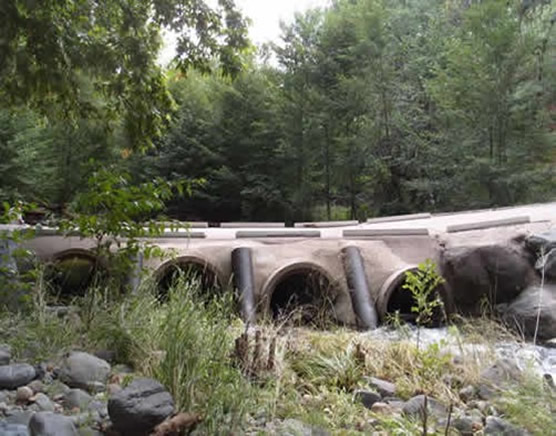
Circular culverts are used at the current crossing. The current circular culverts have a diameter of four feet; the circular culverts modeled in HEC-RAS below are ten feet in diamater. Circular culverts have the highest propensity to cause debris to clog within the culverts.
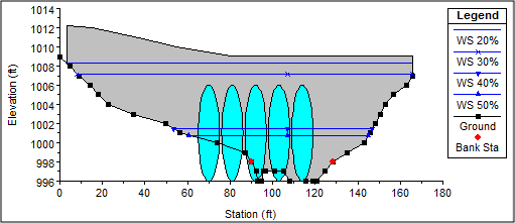
The HEC-RAS model shown above has five ten foot diameter culverts modeled at the current crossing location. The blue lines indicate the two- (50%), three- (40%), four- (30%), and five-year floods (20%). This new design can withstand up to the five-year flood, but there is a high possibility for debris to pile up in the culvert. Also, this design does not address the environmental concern of the scour hole downstream from the crossing.
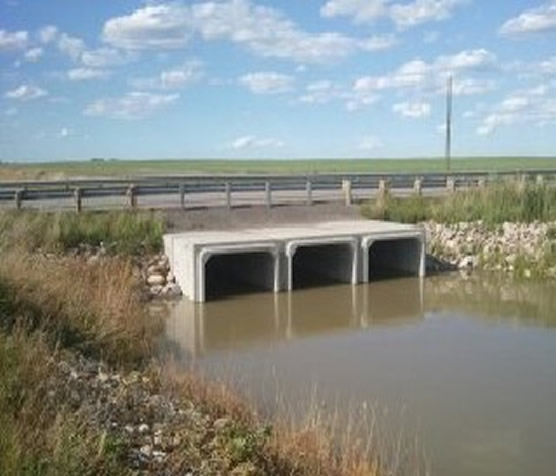
http://culvertdesign.com/wp-content/uploads/2012/09/BF8472_-059.jpg
Box culverts would provide a larger opening space than circular culverts which will help reduce the probability of debris getting stuck in the culvert. However, box culverts still do not address the environmental concern with the scour hole downstream and they can still get clogged with rocks or soil deposits that are flowing downstream.

The HEC-RAS model above has four ten feet by ten feet box culverts. The blue lines also show the two-, three-, four-, and five-year floods. The box culvert design can withstand up to the five-year flood.
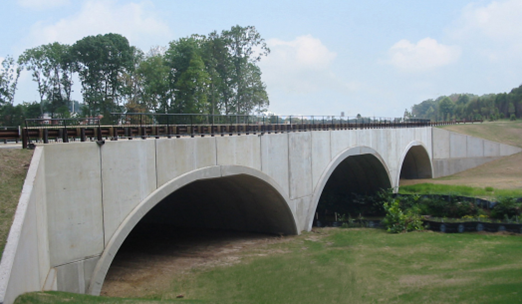
Photo courtesy of Contech©
The three-sided bridge alternative is very similar to a box culvert except it uses the natural stream bed as the bottom of the culvert. The design would allow for rocks and soil deposits to pass under the crossing unhindered. This design is the only design that addresses the environmental concern with the scour hole downstream. The scour hole should minimize over time as Oak Creek returns to a more natural state.
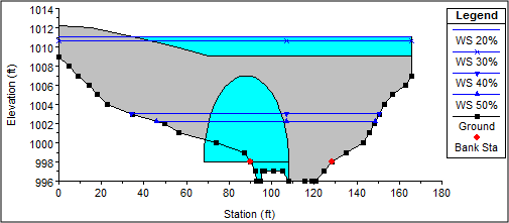
The HEC-RAS model above shows the three-sided bridge design. The blue lines show the two-, three-, four-, and five-year floods. The model indicates that the three-sided bridge option can only withstand up to the three-year flood. However, the environmental benefits of this design have a heavier weight. In order to have the design withstand up to the five-year flood, two confluence culverts, one on each side, should be installed.





